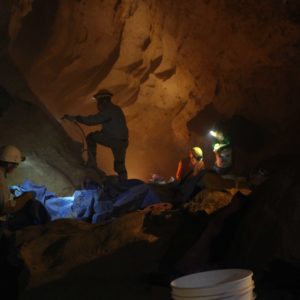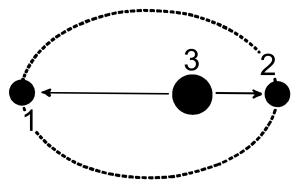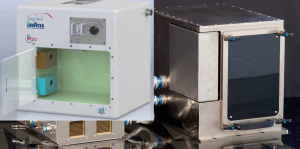![questionable data in χ, pointed out by Brian Skinner [ arXiv:1808.02929]](https://www.laserpodcast.com/wp-content/uploads/2018/08/RT-superconductor-noise-issue-skinner-300x287.png)
questionable data in χ, pointed out by Brian Skinner [arXiv:1808.02929]
We’re back!
You may have heard about some controversy surrounding a recent pre-print published on the arxiv about room temperature superconductivity. This would be an extremely exciting result if it weren’t for some issues. The authors won’t share their samples and have not yet fully described how to make it–they say that will come in a future publication, and there is some question about the veracity of two plots in one of their very important figures.
for some background information and citations for things I talked about:
While I was taking notes, I ended up writing them like a blog post instead of just my normal index card podcast notes, so here is an approximate transcript of the entire episode:
I wanted to share a recent paper that has been making some waves among the scientific community and on twitter about a claim of room temperature superconductivity. I’ll probably regret speaking out about this so early, so I’ll maybe treat this like a paper review and we’ll see how the data work out with peer review and reproducibility. A group from the respectable Indian Institute of Science, graduate student Dev Kumar Thapa and associate professor Anshu Pandey, have posted a pre-print paper on the arxiv called Evidence for Superconductivity at Ambient Temperature and Pressure in Nanostructures. Since this is the arxiv, this is an unfinished pre-print of a paper, not a peer-reviewed manuscript in final form, but it is a fast way to get it out and free to read. There will of course be links in the show notes. The most important part is they claim to have measured superconductivity at 236 K in silver nanoparticles embedded in a gold matrix. This claim is really remarkable when you look at other superconductors. A regular metal superconductor has a Tc less than 9.2 K, which is the highest Tc metal, Niobium. After this, the high temperature binary alloys go up a little bit toward 30 K, and the high temperature cuprates are all very complex structures like YBCO, BSSCO, and HBCCO are 92, 110, and 133 K respectively. Im going to start off ignoring the current controversy and saying that overall this paper is not bad, the claim is extraordinary but they characterized their material extensively, and documented all the things that I would have asked for. Assuming the data are correct and independently reproducible, this could be a very serious discovery.
So before I get too deep into the paper here’s a really quick summary of superconductors for anyone who might not know what they are. A superconductor is a material that conducts electrons with no resistance, they are important for high tech devices and scientific research, and especially in wireless communications and extremely sensitive sensor applications. The primary goal here is to build these high tech devices that require the unique properties of superconductors, not to get zero-loss power lines (although there is a group trying that). The two types of superconductor are those that screen or block magnetic fields completely (these are Type I superconductors) and those that allow magnetic fields to pass through tiny pinholes of normal material called fluxons or flux vorticies (these are Type II). The easy way to guess which type a superconductor is is just to remember that for the most part, pure metal superconductors are all type I (as in they exclude magnetic fields completely until the field gets so strung it shuts off the superconductivity completely, this is called the Meisner effect), while compounds are mostly type II (as in they allow magnetic fields through little flux vorticies up to a point where the field destroys superconductivity completely). These magnetic fields are referred to as Hc1 and Hc2 (as in H, the magnetic field, c for critical, 1 where flux vorticies are formed and 2 for where superconductivity is destroyed completely).
Okay, that should be enough background for what I’m going to say, so on to the publication. Like I said earlier, their remarkable claim is to have measured superconductivity at 236 K in nanostructures of silver nanoparticles (about 10 nm) embedded in a gold matrix. An easy thing to point out is that neither gold nor silver are superconducting on their own, and based on their chemical and structural analysis this is not an alloy, so these support the authors’ claim that the property has something to do with the nano structure.
• Their structures at large (micron) scale don’t have good uniformity, but this is pretty typical for this type of work, and the actual nano particles have good uniform size distribution and shape (this of course coming from someone who doesn’t ever work with nanoparticles).
After that is the part where I start having little issues with things. Now, a little context I spent over a year working with unvalidated claims of room temperature superconductivity in the past, and I’m also currently writing my dissertation, so I am in the mindset to look critically at everything as “this could be better if.” I’m saying this because want to point out that this part of the discussion isn’t ripping the authors work apart, just offering criticisims on a paper that isn’t peer reviewed or published yet. These are the same things the reviewers and editors will also pick up and fix before final publication.
The 2nd figure shows the resistance vs temperature transition
• R-T drop is good, clear and obvious resistance drop indicative of superconductivity, and this is the normal way you would check for it. The weird thing about this figure 2-a where they show the resistance vs temperature is that they are reporting the data in resistance instead of resistivity. Resistance is kind of a rough measurement because its so dependent on measurement geometry and sample size and thickness. This kind of result should be in resistivity so that it is universal.
• From a quick calculation of resistivity, even at “normal” temperatures this gold is very conductive for such a thin film, especially one that is nanostructured. The normal resistivity is comparable to that of pure gold, and while its hard to increase the resistivity of gold by adding contaminants, these nanostructures don’t look like they are continuous and probably shouldn’t be so conductive.
• Figure 2-B is fine data, but axes backwards hard to read (magnet field is independent variable should be on x)
• Figure 3: other way to detect superconductivity is magnetic susceptibility
o A few weird units in the paragraph, g/cc and “(si units)” for susceptibility is switching from CGS to SI, and also weird medical.
o Susceptibility goes to -0.06, should be -1 for perfect diamagnet (superconductor) suggests only 6% of material is superconducting (they blame on imperfect sintering- could be, wouldn’t detract from discovery)
o Same issue with independent variable on y-axis
o Brian skinner post-doc @ MIT pointed out on twitter and published in arxiv
o Unlikely to be a repeatable noise because its not the same in all the runs
o The data changes halfway up so that the transitions are different
o Looks like one or two of these curves could be faked or manipulated.
• Figure 4: a is interesting, shows decreasing gold fraction increases Tc (why did they pick a the 236 K sample to focus their paper on)
o Doesn’t include their highest temperature specimen, even an arrow or blank space.
o Figures b and c are pretty useless, and not sure what they are showing or why. Even after reading, these seem unnecessary and not helpful. B is just noise but not labeled in the figure or anything and C is not noise even though it should be.
• In the supplemental, my first issue is with S3, this is a blurry screenshot of a EDS spectra form an analysis software, not an publication quality original graphic with most of the peaks labeled but not all of them. It would have been wise to label the giant copper peak from the grid so that people who see it and don’t recognize it immediately know what that element is.
• Then figure S8 is just “transitions in resistivity as observed in three different NS samples” no descriptions or indication why we want to see three random samples after already seeing a bunch of this measurement. Also the resistance and pattern is significantly different than the figure directly above it, S7. Just looks sketchy.
Podcast: Play in new window | Download
Subscribe: Apple Podcasts |



![questionable data in χ, pointed out by Brian Skinner [ arXiv:1808.02929]](https://www.laserpodcast.com/wp-content/uploads/2018/08/RT-superconductor-noise-issue-skinner-300x287.png)







Recent Comments